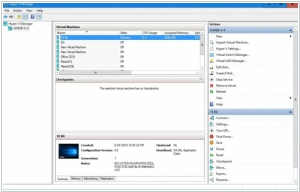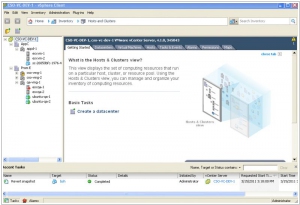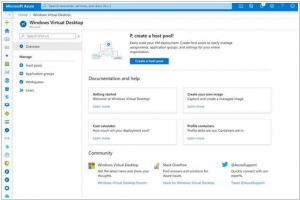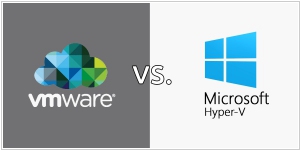Microsoft Hyper-V vs VMware vSphere
May 27, 2023 | Author: Michael Stromann
10

Microsoft Hyper-V provides enterprise-class virtualization for your datacenter and hybrid cloud. Bolster IT efficiency and flexibility with the faster application deployment and maintenance that Microsoft virtualization solutions deliver. Reduce costs by consolidating more workloads on fewer servers and increase agility using the same virtualization platform on-premises and in the cloud.
16

Build your own cloud infrastructure in your datacenter and remote sites on VMware vSphere the world’s leading server virtualization platform. Virtualize your x86 server resources and aggregate them into logical pools for allocation of multiple workloads. Get network services optimized for the virtual environment, along with simplified administration and management. Reduce the complexity of back-end storage systems and enable the most efficient storage utilization in cloud infrastructures.
Microsoft Hyper-V and VMware vSphere are both popular virtualization platforms used to create and manage virtual machines (VMs) in enterprise environments. While they share similarities in terms of core virtualization features, there are notable differences between the two.
1. Vendor Ecosystem: VMware vSphere is a comprehensive virtualization solution offered by VMware, a leader in virtualization technology. It has a mature ecosystem and a wide range of products and services designed to support enterprise-level virtualization needs. Microsoft Hyper-V, on the other hand, is part of the Microsoft ecosystem, providing integration with other Microsoft products such as Windows Server and System Center. Depending on the existing infrastructure and preferred vendor, organizations may have a preference for one over the other.
2. Licensing and Cost: Licensing models and costs differ between Hyper-V and vSphere. Hyper-V is included as a feature within Windows Server, making it an attractive choice for organizations already using Windows Server. On the other hand, VMware vSphere typically requires separate licensing and is associated with additional costs. Organizations need to consider their budget and licensing requirements when choosing between the two.
3. Management and Administration: Both Hyper-V and vSphere offer robust management and administration capabilities, allowing administrators to create, configure, and monitor virtual machines and host systems. vSphere has a reputation for its comprehensive management tools, including vCenter Server, which provides centralized management and advanced features like live migration (vMotion) and high availability (HA). Hyper-V relies on Microsoft System Center for enhanced management capabilities, providing features like virtual machine manager (VMM) and operations manager.
4. Market Share and Support: VMware vSphere has traditionally held a larger market share in the virtualization space and has a strong presence in enterprise environments. This leads to a more extensive support community, a broader range of third-party integrations, and a wider selection of training resources. While Hyper-V has gained traction in recent years and has a growing user base, it may be more prevalent in organizations that heavily rely on Microsoft technologies.
See also: Top 10 Virtualization platforms
1. Vendor Ecosystem: VMware vSphere is a comprehensive virtualization solution offered by VMware, a leader in virtualization technology. It has a mature ecosystem and a wide range of products and services designed to support enterprise-level virtualization needs. Microsoft Hyper-V, on the other hand, is part of the Microsoft ecosystem, providing integration with other Microsoft products such as Windows Server and System Center. Depending on the existing infrastructure and preferred vendor, organizations may have a preference for one over the other.
2. Licensing and Cost: Licensing models and costs differ between Hyper-V and vSphere. Hyper-V is included as a feature within Windows Server, making it an attractive choice for organizations already using Windows Server. On the other hand, VMware vSphere typically requires separate licensing and is associated with additional costs. Organizations need to consider their budget and licensing requirements when choosing between the two.
3. Management and Administration: Both Hyper-V and vSphere offer robust management and administration capabilities, allowing administrators to create, configure, and monitor virtual machines and host systems. vSphere has a reputation for its comprehensive management tools, including vCenter Server, which provides centralized management and advanced features like live migration (vMotion) and high availability (HA). Hyper-V relies on Microsoft System Center for enhanced management capabilities, providing features like virtual machine manager (VMM) and operations manager.
4. Market Share and Support: VMware vSphere has traditionally held a larger market share in the virtualization space and has a strong presence in enterprise environments. This leads to a more extensive support community, a broader range of third-party integrations, and a wider selection of training resources. While Hyper-V has gained traction in recent years and has a growing user base, it may be more prevalent in organizations that heavily rely on Microsoft technologies.
See also: Top 10 Virtualization platforms
Microsoft Hyper-V vs VMware vSphere in our news:
2020. Microsoft makes it easier to get started with Windows Virtual Desktops

Windows Virtual Desktop, Microsoft's service designed to provide employees with access to a virtualized desktop environment on Azure, has introduced a new and improved management experience to simplify administrative tasks. This update aims to streamline the initial setup process for administrators, making it more convenient to get started with the service. Alongside enhancing the management experience, Microsoft is introducing a new capability that enables the use of Microsoft Teams for video meetings within these virtual desktop environments. This functionality, known as 'A/V redirection,' allows users to seamlessly connect their local audio and video hardware to virtual machines with minimal latency. It is important to note that this feature will be gradually rolled out over the next month or so.
2011. Microsoft Hyper-V vs VMware: video

In recent times, Microsoft's marketing team has been known for creating humorous videos targeting their competitors. One such video has emerged, focusing on GMail, and now they have released another video targeting VMWare, their main competitor in the virtualization market. The video showcases Tad, a salesman at VMLimited, a company seemingly stuck in the IT past. Tad attends business meetings with clients in his cool minivan, attempting to sell them his "limited" virtualization system while other companies are already offering private clouds. This represents modern IT humor, where Tad claims to be selling a cloud, but in reality, he is offering nothing more than virtualization. One can only imagine the reaction of Larry Ellison if he were to hear this, as it might make his hair stand on end.



